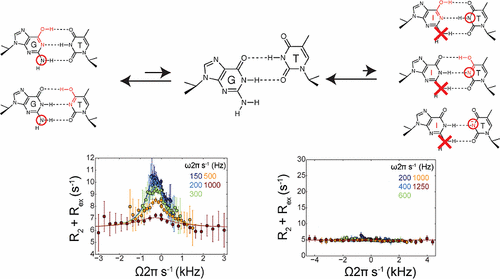当前位置:
X-MOL 学术
›
J. Am. Chem. Soc.
›
论文详情
Our official English website, www.x-mol.net, welcomes your
feedback! (Note: you will need to create a separate account there.)
Direct NMR Evidence that Transient Tautomeric and Anionic States in dG·dT Form Watson–Crick-like Base Pairs
Journal of the American Chemical Society ( IF 14.4 ) Pub Date : 2017-03-20 , DOI: 10.1021/jacs.7b01156 Eric S Szymanski 1 , Isaac J Kimsey 1 , Hashim M Al-Hashimi 1, 2
Journal of the American Chemical Society ( IF 14.4 ) Pub Date : 2017-03-20 , DOI: 10.1021/jacs.7b01156 Eric S Szymanski 1 , Isaac J Kimsey 1 , Hashim M Al-Hashimi 1, 2
Affiliation

|
The replicative and translational machinery utilizes the unique geometry of canonical G·C and A·T/U Watson-Crick base pairs to discriminate against DNA and RNA mismatches in order to ensure high fidelity replication, transcription, and translation. There is growing evidence that spontaneous errors occur when mismatches adopt a Watson-Crick-like geometry through tautomerization and/or ionization of the bases. Studies employing NMR relaxation dispersion recently showed that wobble dG·dT and rG·rU mismatches in DNA and RNA duplexes transiently form tautomeric and anionic species with probabilities (≈0.01-0.40%) that are in concordance with replicative and translational errors. Although computational studies indicate that these exceptionally short-lived and low-abundance species form Watson-Crick-like base pairs, their conformation could not be directly deduced from the experimental data, and alternative pairing geometries could not be ruled out. Here, we report direct NMR evidence that the transient tautomeric and anionic species form hydrogen-bonded Watson-Crick-like base pairs. A guanine-to-inosine substitution, which selectively knocks out a Watson-Crick-type (G)N2H2···O2(T) hydrogen bond, significantly destabilized the transient tautomeric and anionic species, as assessed by lack of any detectable chemical exchange by imino nitrogen rotating frame spin relaxation (R1ρ) experiments. An 15N R1ρ NMR experiment targeting the amino nitrogen of guanine (dG-N2) provides direct evidence for Watson-Crick (G)N2H2···O2(T) hydrogen bonding in the transient tautomeric state. The strategy presented in this work can be generally applied to examine hydrogen-bonding patterns in nucleic acid transient states including in other tautomeric and anionic species that are postulated to play roles in replication and translational errors.
中文翻译:

dG·dT 中瞬时互变异构和阴离子态形成 Watson-Crick 类碱基对的直接 NMR 证据
复制和翻译机器利用规范 G·C 和 A·T/U Watson-Crick 碱基对的独特几何形状来区分 DNA 和 RNA 错配,以确保高保真度复制、转录和翻译。越来越多的证据表明,当错配通过碱基的互变异构和/或电离而采用类似 Watson-Crick 的几何形状时,就会发生自发错误。最近采用 NMR 弛豫色散的研究表明,DNA 和 RNA 双链体中的摆动 dG·dT 和 rG·rU 错配会瞬时形成互变异构体和阴离子物质,其概率 (约 0.01-0.40%) 与复制和翻译错误一致。尽管计算研究表明这些异常短命和低丰度的物种形成了类似沃森-克里克的碱基对,但它们的构象不能直接从实验数据中推断出来,并且不能排除替代的配对几何形状。在这里,我们报告了直接的核磁共振证据,表明瞬时互变异构体和阴离子物质形成氢键沃森-克里克样碱基对。鸟嘌呤到肌苷的取代选择性地敲除沃森-克里克型 (G)N2H2·O2(T) 氢键,显着破坏了瞬时互变异构体和阴离子物种的稳定性,通过缺乏任何可检测到的化学交换来评估通过亚氨基氮旋转框架自旋弛豫(R1ρ)实验。针对鸟嘌呤(dG-N2)氨基氮的 15N R1ρ NMR 实验为瞬时互变异构状态下的 Watson-Crick (G)N2H2·O2(T) 氢键提供了直接证据。 这项工作中提出的策略通常可用于检查核酸瞬态中的氢键模式,包括假定在复制和翻译错误中发挥作用的其他互变异构体和阴离子物种中的氢键模式。
更新日期:2017-03-20
中文翻译:

dG·dT 中瞬时互变异构和阴离子态形成 Watson-Crick 类碱基对的直接 NMR 证据
复制和翻译机器利用规范 G·C 和 A·T/U Watson-Crick 碱基对的独特几何形状来区分 DNA 和 RNA 错配,以确保高保真度复制、转录和翻译。越来越多的证据表明,当错配通过碱基的互变异构和/或电离而采用类似 Watson-Crick 的几何形状时,就会发生自发错误。最近采用 NMR 弛豫色散的研究表明,DNA 和 RNA 双链体中的摆动 dG·dT 和 rG·rU 错配会瞬时形成互变异构体和阴离子物质,其概率 (约 0.01-0.40%) 与复制和翻译错误一致。尽管计算研究表明这些异常短命和低丰度的物种形成了类似沃森-克里克的碱基对,但它们的构象不能直接从实验数据中推断出来,并且不能排除替代的配对几何形状。在这里,我们报告了直接的核磁共振证据,表明瞬时互变异构体和阴离子物质形成氢键沃森-克里克样碱基对。鸟嘌呤到肌苷的取代选择性地敲除沃森-克里克型 (G)N2H2·O2(T) 氢键,显着破坏了瞬时互变异构体和阴离子物种的稳定性,通过缺乏任何可检测到的化学交换来评估通过亚氨基氮旋转框架自旋弛豫(R1ρ)实验。针对鸟嘌呤(dG-N2)氨基氮的 15N R1ρ NMR 实验为瞬时互变异构状态下的 Watson-Crick (G)N2H2·O2(T) 氢键提供了直接证据。 这项工作中提出的策略通常可用于检查核酸瞬态中的氢键模式,包括假定在复制和翻译错误中发挥作用的其他互变异构体和阴离子物种中的氢键模式。











































 京公网安备 11010802027423号
京公网安备 11010802027423号